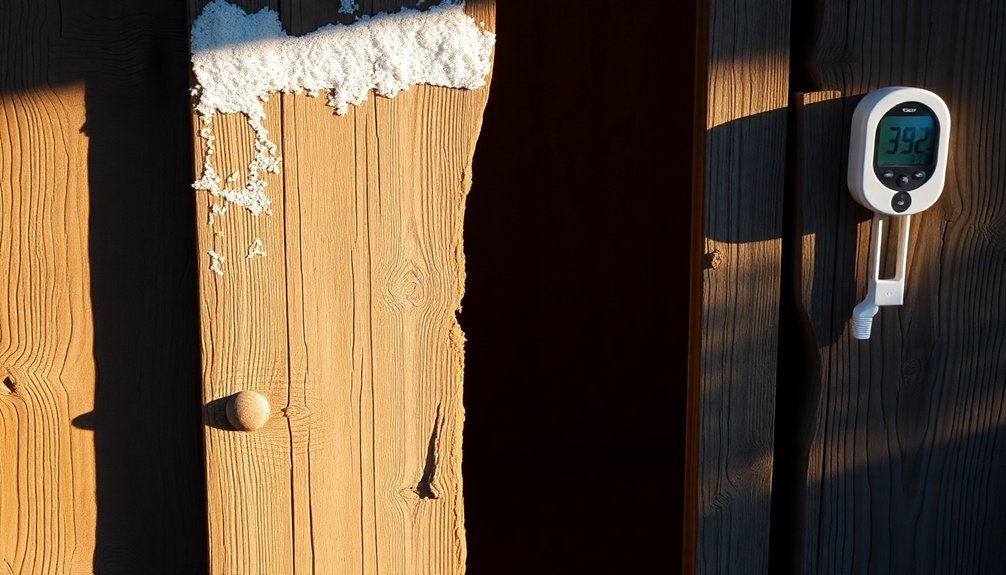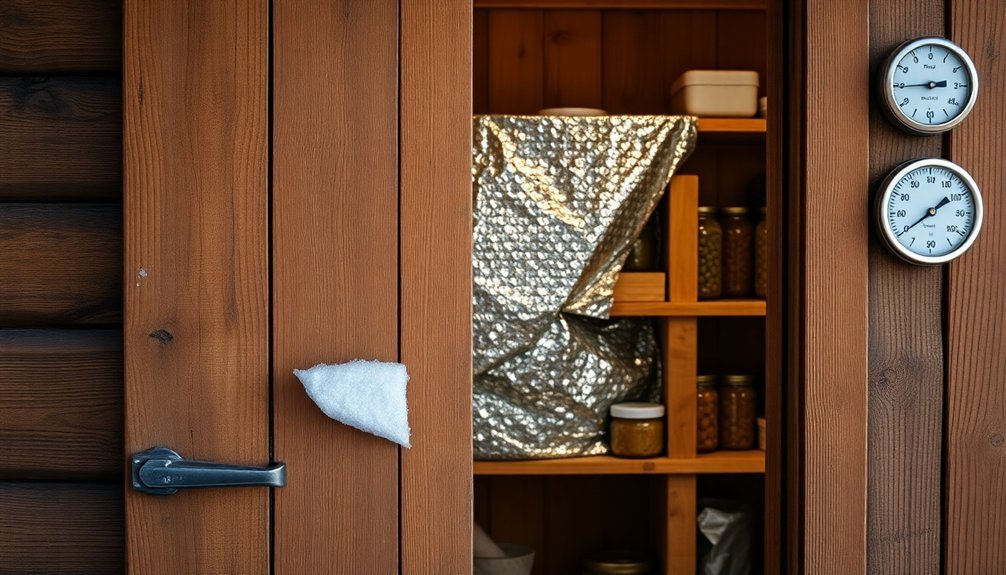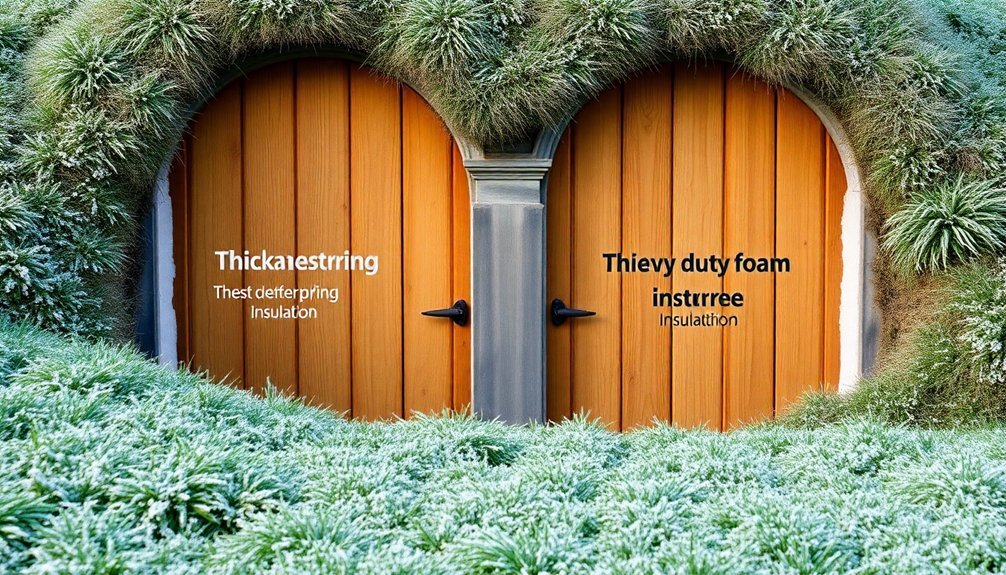Double-insulating your root cellar door offers significant benefits for food storage and energy efficiency. You'll maintain ideal preservation temperatures between 32-40°F while cutting energy costs by up to 15%. The double layer creates a strong barrier against external temperature fluctuations, protecting your stored produce from spoilage and extending its shelf life. With proper insulation materials like foam plastics or natural cork, you'll prevent moisture damage and reduce unwanted heat transfer. This investment pays for itself through lower utility bills and better-preserved food. There's much more to discover about maximizing your root cellar's potential through effective door insulation.
Understanding Double Door Insulation Benefits

A root cellar's effectiveness hinges on proper insulation, and double-insulating your cellar door provides multiple essential benefits. When you double-insulate your door, you'll create a powerful barrier that minimizes heat transfer between the outside and inside environments, ensuring your cellar maintains consistent temperatures year-round.
You'll notice immediate improvements in your cellar's energy efficiency, as the double insulation keeps cold air in and warm air out. This stability is vital for extending the storage life of your produce while reducing the energy needed to maintain ideal conditions. Using at least 6 inches of natural cork or styrofoam insulation in doors provides optimal temperature control.
The enhanced insulation also helps control moisture levels, preventing condensation and reducing the risk of mold growth that could compromise your stored items.
Your door's structural integrity will benefit greatly from double insulation. You'll protect the door materials from temperature extremes and moisture damage, preventing warping and maintaining a tight seal.
This means you won't need frequent adjustments or repairs, and your door will operate smoothly for years to come. While the initial investment might be higher, you'll save money through improved energy efficiency and extended produce storage life, making double insulation a smart, practical choice for your root cellar.
Selecting Proper Insulation Materials
Selecting the right insulation materials for your root cellar door involves weighing four main categories: foam plastics, natural cork, fiberglass, and eco-friendly alternatives.
Foam plastics and Styrofoam are popular choices due to their high insulating value. The JR-Holvikaari design recommends installing them at 20mm thickness per sheet. You'll want to install them in layers of 6 to 12 inches thick, ensuring proper overlap to eliminate heat-leaking gaps.
If you're in a tropical region, consider natural cork as your primary insulator. It's non-toxic and provides excellent thermal protection when installed at least 6 inches thick.
For a formaldehyde-free option, you can choose modern fiberglass products like Owens Corning Pink Next Gen or Certainteed Fiberglass. These materials carry GreenGuard Gold certification, confirming their low VOC emissions and making them safe for your food storage area.
If environmental impact is your primary concern, you've got several eco-friendly options. Dense-packed cellulose made from recycled paper works well in double-door configurations.
You can also use natural materials like volcanic pumice, perlite, or vermiculite in cavity wall constructions. Even rice hulls and corrugated cardboard can serve as effective thermal barriers while maintaining your commitment to sustainability.
Temperature Control Essentials

Temperature control can make or break your root cellar's effectiveness. You'll need to maintain temperatures between 32 and 40 degrees F for ideal food preservation. While earth cooling at 15 feet below grade naturally maintains 50-55 degrees F year-round, you'll need additional measures to achieve perfect conditions. Modern root cellars benefit from foam insulation materials to help moderate temperatures effectively.
| Feature | Purpose | Benefit |
|---|---|---|
| Double Doors | Prevents heat infiltration | Maintains stable temps |
| Double Roof | Blocks sun exposure | Reduces heat gain |
| Controllable Vents | Manages air flow | Regulates temperature |
Your root cellar's temperature stability depends heavily on proper insulation and ventilation systems. You'll want to install insulated doors with at least 6 inches of natural cork or styrofoam, along with exterior insulated steel doors for maximum temperature management. Don't forget to include wrap-around porches to shield walls from direct sunlight.
To maintain consistent temperatures, you'll need dual vents at ceiling and ground levels. These vents promote full air circulation while preventing stagnant air pockets. Remember to air-seal the ceiling using thermal breaks like Polyiso to prevent heat transfer from living spaces above. This thorough approach guarantees your root cellar maintains the cool temperatures necessary for long-term food storage.
Installation Steps and Guidelines
Before you start installing your root cellar's double-door system, take precise measurements of the entire doorway area and plan your material layout to guarantee proper coverage and fit.
You'll need to build up your insulation in methodical layers, starting with the door frame and working your way to both doors, using cork or styrofoam at least 6 inches thick.
Once you've secured all insulation layers with Tapcon screws and protective covering, test the seal by closing both doors and checking for any air leaks with a smoke pencil or infrared thermometer.
Measure and Plan Layout
Precise measurements serve as the foundation for a properly insulated root cellar door. You'll need to measure both the interior and exterior dimensions of your door frame, accounting for any irregularities or gaps that could compromise the insulation's effectiveness.
Make certain to measure the door thickness, as this will determine the depth of insulation required to maintain ideal temperature control.
When planning your layout, you'll want to create a detailed sketch that includes the positioning of both insulation layers. Consider how the layers will interact with the door's hardware and whether you'll need to make adjustments to accommodate hinges and latches.
It's essential to plan for proper sealing around the edges where moisture infiltration is most likely to occur.
Your layout should also account for the door's weight capacity, as double insulation will add considerable mass. You'll need to guarantee your hinges and frame can support the additional weight without compromising structural integrity.
Consider mapping out ventilation channels if needed, as proper airflow helps regulate humidity levels while maintaining the effectiveness of your insulation system.
Layer Installation Process
The systematic installation of insulation layers requires careful attention to detail and proper sequencing.
You'll need to begin by cutting your rigid foam insulation boards to the precise measurements you've taken, guaranteeing they'll fit within your door frame while accounting for door stops. Use a sharp blade to make clean, accurate cuts, and don't forget to mark and cut out space for your door handle.
Next, you'll apply adhesive specifically designed for foam board insulation. Focus on applying it around the perimeter of the door where it's most effective for binding. Don't waste adhesive in the center areas where it won't contribute to securing the insulation.
Mount your first layer carefully, making sure it's properly aligned and seated against the door surface. As you add subsequent layers, secure each one firmly to the previous layer, checking that the door still operates smoothly after each addition.
During installation, you'll want to maintain even spacing between layers and verify there aren't any gaps or air leaks around the edges. Once you've mounted all layers, wipe away any excess adhesive and test the door's operation under various conditions to guarantee proper functionality.
Sealing and Testing
Proper sealing transforms an ordinary root cellar door into an efficient barrier against temperature fluctuations. You'll need to carefully apply rubber weather stripping around the door frame, guaranteeing no gaps remain. Install a TRIM-LOK Ribbed Rectangle Rubber Seal along the edges for maximum durability and protection against the elements.
| Testing Phase | What to Check | Action Required |
|---|---|---|
| Air Leaks | Door gaps and edges | Apply Duck Brand Self Adhesive |
| Temperature | Consistency over 24 hours | Add Yotache Foam Stripping |
| Ventilation | Air flow through vents | Adjust vent positions |
| Humidity | Moisture levels | Modify air circulation |
After applying the initial seals, conduct a thorough test using a smoke pencil to identify any remaining air leaks. Place one hand near the door edges to feel for drafts. If you detect any issues, apply additional layers of weather stripping or foam tape as needed. Don't forget to test the door's functionality after sealing – it should close smoothly without catching. Monitor the temperature inside your root cellar for at least 24 hours after sealing to guarantee stability, and adjust ventilation if needed to prevent ethylene gas buildup.
Maximizing Storage Life

Successfully maximizing storage life within your root cellar depends on maintaining ideal temperature, humidity, and air circulation throughout the space. Your double-insulated door plays a vital role in creating the perfect environment by maintaining temperatures between 32 and 40°F, which is essential for long-term produce storage.
You'll achieve best storage conditions when your door helps maintain humidity levels between 60-85%. This balance prevents mold growth while keeping your vegetables and fruits from drying out. The door's insulation minimizes air leakage, protecting against external temperature fluctuations that could compromise your stored produce.
Your double-insulated door's design also supports proper air circulation, which you'll need to remove ethylene gas and vegetable odors that can accelerate spoilage. By controlling air intake and outlet points, you're creating a consistent flow that prevents warm air pockets near the ceiling.
You'll extend your produce's shelf life by keeping the storage area dark and protecting it from pests and contaminants. The door's insulation prevents damaging freeze-thaw cycles and helps maintain the stable environment your vegetables and fruits need to stay fresh longer.
Energy Efficiency Through Insulation
Double-insulating your root cellar door gives you superior temperature control by maintaining consistent conditions for your stored produce.
You'll notice significant cost savings on your energy bills since the enhanced insulation reduces the strain on your heating and cooling systems.
Temperature Control Benefits
Through careful insulation of your root cellar door, you'll achieve remarkable temperature control that greatly reduces energy costs while maintaining perfect storage conditions.
Double-insulated doors create a robust barrier against external temperature fluctuations, ensuring your stored produce remains at the best temperatures year-round. You'll find that proper insulation, especially when using materials like natural cork or styrofoam, considerably enhances your cellar's ability to maintain consistent cooling without relying on artificial refrigeration.
The temperature control benefits of double-insulated doors manifest in three key ways:
- Your cellar will maintain stable temperatures regardless of outdoor weather changes, as the insulated barrier prevents unwanted heat from seeping through the doorway.
- You'll create an effective seal that works with your ventilation system, allowing cold air to stay inside while warm air is efficiently vented out.
- Your storage space will benefit from natural cooling properties, reducing the need for energy-consuming cooling methods.
This passive temperature control system, supported by proper door insulation, creates an ideal environment for long-term food storage while minimizing your energy consumption through natural cooling methods.
Cost Savings Over Time
A well-insulated root cellar door proves to be a smart financial investment, offering substantial energy savings over time.
You'll notice immediate benefits through reduced energy consumption, as proper insulation can cut your total energy costs by up to 11%. When you double-insulate your door, you're creating a more efficient barrier that helps maintain consistent temperatures, leading to average savings of 15% on heating and cooling expenses.
The long-term financial benefits extend beyond just utility bills. Your insulated door will help preserve stored produce more effectively, reducing food waste and the need for frequent replacements.
You won't have to spend as much on door maintenance either, since insulation protects against temperature-related damage like warping and cracking. The door's enhanced durability means you'll save on repair and replacement costs that often come with non-insulated alternatives.
While there's an initial investment in double insulation, you'll recover these costs through continued energy savings and reduced maintenance expenses.
The combination of lower utility bills, decreased food spoilage, and extended door lifespan makes this upgrade particularly cost-effective, especially if you're in an area with extreme temperature variations.
Reduced Environmental Impact
Beyond financial advantages, your insulated root cellar door plays a notable role in environmental conservation. By double-insulating your door, you're creating an essential barrier that maintains consistent temperatures between 50-55°F year-round, considerably reducing the need for artificial heating or cooling systems. This reduction in energy consumption directly translates to lower greenhouse gas emissions and a smaller carbon footprint.
Your double-insulated door contributes to environmental sustainability in three key ways:
- Minimizes air leaks that would otherwise waste energy equivalent to leaving a window open year-round.
- Reduces the demand for new insulation materials by utilizing recycled options when possible.
- Decreases the energy needed for temperature regulation by effectively harnessing the earth's natural ambient temperature.
The environmental benefits extend beyond just energy savings. When you choose recycled insulation materials, you're supporting a circular economy and reducing waste in landfills.
Additionally, your well-insulated door helps regulate humidity levels naturally, eliminating the need for energy-intensive dehumidification systems. This thorough approach to insulation demonstrates how small improvements to your root cellar can contribute to broader environmental conservation efforts.
Weather Protection Strategies

Effective weather protection for your root cellar starts with strategic design elements that shield against environmental stresses.
You'll want to incorporate a wrap-around porch to protect your cellar's walls from direct sunlight, which can greatly affect internal temperatures. This architectural feature works in conjunction with your double-insulated door system to maintain consistent conditions.
For above-ground structures, you'll need to implement a double-roof system. This consists of an inner weather-proof roof topped by an outer sun roof, creating a protective air space that prevents heat transfer.
You can enhance this protection by using structurally insulated panels (SIPs) for quick and efficient insulation of your exterior walls.
When planning your door's weather protection, consider how it integrates with your ventilation system.
You'll need dual vents – one at ceiling level and another at ground level – to guarantee proper air circulation.
Make sure your double-door setup includes proper weather stripping and seals to prevent unwanted air infiltration.
If you're using insulated steel doors, choose pre-hung options that come with built-in weather protection features for ideal performance.
Preserving Food Quality Year Round
Maintaining year-round food quality in your root cellar depends heavily upon a properly double-insulated door system. When you've double-insulated your door, you'll create the perfect environment where vegetables and fruits can maintain their flavor, texture, and nutritional value for extended periods.
Your stored produce will benefit from consistent temperatures between 32°F to 40°F, coupled with humidity levels of 85-95%.
You'll notice these tangible benefits in your food preservation efforts:
- Your root vegetables will stay crisp and firm for months, as the regulated environment prevents premature sprouting and decay.
- Your apples and pears won't shrivel or become mealy, thanks to the controlled humidity levels that prevent moisture loss.
- Your onions and garlic will maintain their distinct flavors without sprouting, as the stable temperature inhibits unwanted growth.
The double-insulated door system helps you maximize your harvest's longevity by preventing ethylene gas buildup, which can accelerate spoilage.
You'll be able to store larger quantities of seasonal produce without relying on electricity-hungry refrigeration, and you won't need to worry about frequent replacements due to spoilage.
This means you can enjoy your garden's bounty throughout the year while maintaining ideal nutritional value.
Frequently Asked Questions
How Often Should Insulation Materials in Root Cellar Doors Be Replaced?
You'll need to replace your root cellar door's insulation every 15-30 years, but check annually for signs of damage, compression, or moisture. Replace it sooner if you notice degradation or temperature control issues.
Can Double-Insulated Doors Be Retrofitted to Existing Root Cellars?
Yes, you can retrofit double-insulated doors to your existing root cellar. You'll need to guarantee the frame's compatible, install proper weather stripping, and may need professional help for a proper airtight seal.
What's the Cost Difference Between Single and Double-Insulated Root Cellar Doors?
You'll spend about $500-$1,500 more for a double-insulated door compared to a single-insulated one. While single doors cost $500-$1,500, double-insulated versions range from $1,000-$3,500, depending on materials used.
Do Double-Insulated Doors Require Special Maintenance During Extreme Weather Conditions?
Yes, you'll need to check insulation and seals more frequently during extreme weather. You should monitor temperature fluctuations, guarantee weather-stripping remains intact, and watch for moisture issues that could compromise the door's effectiveness.
Can Solar Heat Gain Affect Double-Insulated Doors in South-Facing Root Cellars?
Yes, your south-facing root cellar's double-insulated door can be affected by solar heat gain, especially if it contains glass. You'll need doors with low SHGC ratings or no windows to minimize this impact.
In Summary
Double-insulating your root cellar door isn't just about keeping food fresh – it's essential for maintaining consistent temperatures and preventing costly energy loss. You'll extend your stored food's shelf life, protect against weather fluctuations, and create a more reliable storage environment. By taking the time to properly insulate both door layers, you're investing in better food preservation and reducing the need for artificial climate control.





Leave a Reply